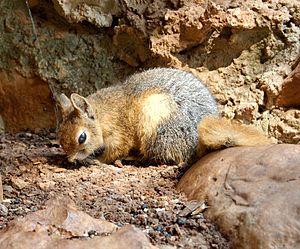Caucasian squirrel facts for kids
Quick facts for kids Caucasian squirrel |
|
|---|---|
 |
|
| Conservation status | |
| Scientific classification | |
| Genus: |
Sciurus
|
| Species: |
anomalus
|
| Subspecies | |
|
|
 |
|
| Persian squirrel's range | |
The Caucasian squirrel (Sciurus anomalus), also called the Persian squirrel, is a type of tree squirrel. You can find these squirrels in forests across southwestern Asia. They live in places with mixed forests that have different kinds of trees.
Scientists first officially described this squirrel in 1785. A scientist named Johann Anton Güldenstädt was the first to give it its scientific name.
Contents
What Do Caucasian Squirrels Look Like?
Caucasian squirrels are small tree squirrels. They usually measure about 32 to 36 centimeters (12.5 to 14 inches) long. This length includes their tail, which is about 13 to 18 centimeters (5 to 7 inches) long. These squirrels weigh between 250 and 410 grams (about 0.5 to 0.9 pounds).
Their fur color can change depending on where they live. The fur on their backs is usually grayish-brown to pale gray. Their bellies are a rusty brown or yellowish color. Their tails can be yellow-brown to a deep red. Compared to other tree squirrels, their claws are quite short. Female squirrels usually have eight or ten teats.
Where Do Caucasian Squirrels Live?
Caucasian squirrels are native to southwestern Asia. You can find them in countries like Turkey, Iran, Israel, and Jordan. They also live on islands such as Gökçeada and Lesbos. This squirrel is one of only two types of Sciurus squirrels found on Mediterranean islands.
These squirrels mostly live in forests. They prefer areas with lots of oak, pine, and pistachio trees. They can live in forests up to 2,000 meters (about 6,500 feet) high.
Different Types of Caucasian Squirrels
There are three main types, or subspecies, of Caucasian squirrels:
- S. a. anomalus: Found in Turkey and the Caucasus region.
- S. a. pallescens: Lives in the Zagros Mountains, from southeastern Turkey to Iran.
- S. a. syriacus: Found in Lebanon, Syria, Israel, and Jordan.
How Do Caucasian Squirrels Live?
Caucasian squirrels are active during the day, which means they are diurnal. They usually live alone. However, if there's a lot of food, you might see them gather in small groups to eat.
What Do They Eat?
Their diet includes nuts, seeds, and tree shoots. They also eat tree buds. They especially love the seeds from oak and pine trees. Like many other squirrels, they hide their food for later. They might bury it in the ground or store it in tree holes. Some of their hidden food stashes can hold up to 6 kilograms (about 13 pounds) of seeds!
Their Homes and Habits
These squirrels live in trees, where they build their dens. They often make their nests in hollow parts of trees. They line these nests with moss and leaves. These tree nests are usually found 5 to 14 meters (about 16 to 46 feet) above the ground. Sometimes, they also build nests under rocks or tree roots.
Even though they live in trees, they often look for food on the ground. They are not as much "tree-dwellers" as the Eurasian red squirrel. When they sense danger, they make a high-pitched alarm call. This sound is said to be like the call of the European green woodpecker. They also mark their areas using urine and dung.
Baby Squirrels
Caucasian squirrels can have babies throughout the year. However, they have more babies in spring or autumn. A mother squirrel usually has two to seven babies at a time. Three or four babies are most common. The young squirrels grow up quickly and are fully mature by five or six months old.
How Are Caucasian Squirrels Protected?
In 2008, a study showed that there were still many Caucasian squirrels in Turkey. However, their numbers have gone down in the Levant region. For example, a survey in 1993 in Israel suggested they were almost gone from the study area.
Even though they face threats like poaching (illegal hunting) and deforestation (forest clearing), their numbers are not low enough to be considered "endangered." Because of this, the International Union for Conservation of Nature lists them as "Least Concern." This means they are not currently at high risk of disappearing.
Hunting these squirrels is banned by the Central Hunting Commission. The Caucasian squirrel is also protected by international agreements. These include the Bern Convention and the EU Habitats Directive. These rules help keep them safe in their natural homes.



